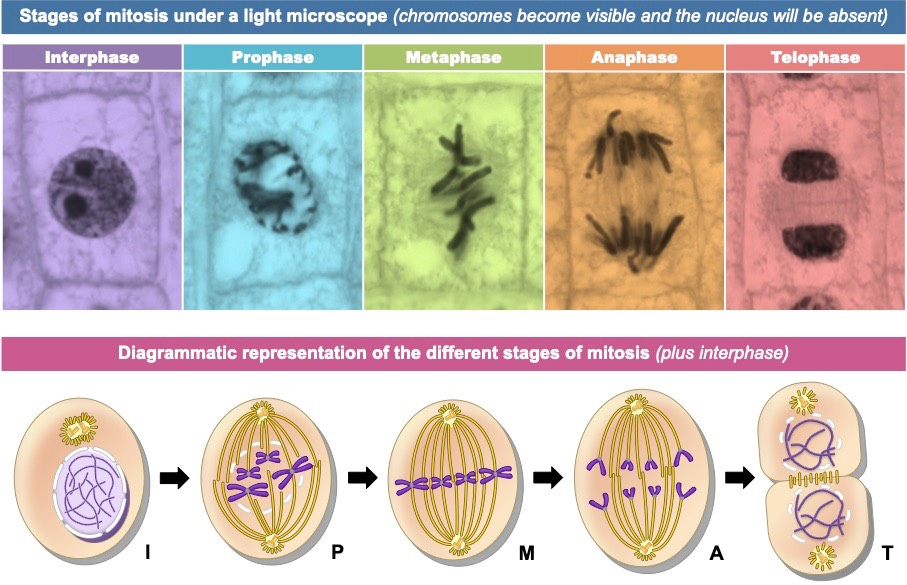Key Knowledge:
|
Cells reproduce by duplicating their cellular contents (including DNA) before undergoing cytoplasmic division to create two cells
- The cell cycle describes the series of ordered events a typical eukaryotic cell undergoes as it grows and divides in two
Cell Cycle
The eukaryotic cell cycle can be divided into two main stages (interphase and M phase), each with multiple sub-phases:
- Interphase is an active period in the cycle, in which a cell grows and prepares for division (includes G1, S and G2 sub-phases)
- The M phase describes the period of actual division and includes mitosis (nuclear division) and cytokinesis (cytoplasmic division)
- Sometimes a cell may leave the cell cycle (from G1) and enter a resting state (G0) where it no longer divides (i.e. it is amitotic)
Interphase:
- G1 – First intermediate gap phase in which a cell grows in size and synthesises the proteins needed for DNA replication
- S – The synthesis stage in which DNA is replicated (along with the microtubule-organising centrosome)
- G2 – Second intermediate gap phase in which a cell continues to grow and all cellular organelles are duplicated
M phase:
- Mitosis – Nuclear division, whereby the duplicated DNA is separated into two genetically identical nuclei
- Cytokinesis – Cytoplasmic division, whereby cellular contents (organelles) are segregated and the cell splits in two

DNA Organisation
Normally, within a cell, the DNA is loosely packed within the nucleus as unravelled chromatin
- In this unravelled form, the DNA is accessible to transcriptional machinery and so genetic information can be translated
- DNA is organised as chromatin in all non-dividing cells and throughout the process of interphase
When a cell divides, the DNA is temporarily packaged into a tightly wound and condensed chromosome (via supercoiling)
- In this condensed form, the DNA is able to be easily segregated however is inaccessible to transcriptional machinery
- DNA is organised as chromosomes during the process of mitosis (condense in prophase, decondense in telophase)
As the DNA is replicated during the S phase of interphase, the chromosome will initially contain two identical DNA strands
- These genetically identical strands are called sister chromatids and are held together by a region called the centromere
- When chromatids separate during mitosis, they become independent chromosomes, each made of a single DNA strand

Mitosis
Mitosis is the process of nuclear division, whereby duplicated DNA molecules are arranged into two separate nuclei
- Mitosis is preceded by interphase and is divided into four distinct stages: prophase, metaphase, anaphase, telophase
- The division of the cytoplasm to form two cells (cytokinesis) occurs concurrently with the final stage of mitosis (telophase)
Interphase (Before Mitosis)
- DNA is present as uncondensed chromatin (not visible under microscope) and is contained within a clearly defined nucleus
- The DNA is replicated (in the S phase) to form genetically identical sister chromatids (connected by a centromere)
- Centrosomes and other organelles have been duplicated and the cell is enlarged in preparation for division
Prophase
- DNA supercoils (i.e. chromosomes condense) and the nuclear membrane breaks down, causing the nucleus to dissolves
- Paired centrosomes (duplicated in the S phase) move to the opposite poles of the cell and form microtubule spindle fibres
Metaphase
- Microtubule spindle fibres from both centrosomes connect to the centromere of each chromosome
- Microtubule depolymerisation causes spindle fibres to shorten, causing chromosomes to align along the centre of the cell
Anaphase
- Continued contraction of the spindle fibres causes the sister chromatids to separate (becoming separate chromosomes)
- The genetically identical chromosomes move to the opposite poles of the cell (where the paired centrosomes are located)
Telophase
- Once the two chromosome sets arrive at the poles, spindle fibres dissolve and the chromosomes decondense
- Nuclear membranes reform around each chromosome set and cytokinesis occurs concurrently, splitting the cell into two

Cytokinesis
Cytokinesis is the process of cytoplasmic division, whereby the cell splits into two identical daughter cells
- Cytokinesis occurs concurrently with the final stage of mitosis (telophase) and is different in plant and animal cells
Animal Cells
- After anaphase, microtubule filaments form a concentric ring around the centre of the cell
- The microfilaments constrict to form a cleavage furrow, which deepens from the periphery towards the centre
- When the furrow meets in the centre, the cell becomes completely pinched off and two cells are formed
- Because this separation occurs from the outside and moves towards the centre, it is described as centripetal

Plant Cells
- After anaphase, carbohydrate-rich vesicles form in a row at the centre of the cell (equatorial plane)
- The vesicles fuse together and an early cell plate begins to form within the middle of the cell
- The cell plate extends outwards and fuses with the cell wall, dividing the cell into two distinct daughter cells
- Because this separation originates in the centre and moves laterally, it is described as centrifugal

Binary Fission
Bacteria do not have a distinct cell cycle and instead has a series of coordinated but independent events (leading to binary fission)
Via the process of binary fission (prokaryotic asexual reproduction):
- The circular DNA is copied in response to a replication signal and then the two DNA loops attach to the cell membrane
- The membrane elongates (drawing the DNA loops apart) and then pinches off to form two separate cells (each with a DNA loop)
Comparison of the Eukaryotic Cell Cycle (Left) and Prokaryotic Binary Fission (Right)